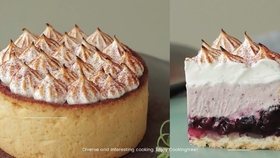Milk in Cake Recipe: A Delightful Journey to Creamy Perfection
Guide or Summary:Milk in Cake Recipe: Unlocking the Secrets of Creamy TextureMilk in Cake Recipe: Enhancing Flavor and MoistureMilk in Cake Recipe: Tips for……
Guide or Summary:
- Milk in Cake Recipe: Unlocking the Secrets of Creamy Texture
- Milk in Cake Recipe: Enhancing Flavor and Moisture
- Milk in Cake Recipe: Tips for Optimal Use
Embark on a tantalizing journey to the heart of creamy, decadent cake recipes that harness the rich, velvety essence of milk. As you delve into the world of baking, you'll uncover the secrets to achieving that perfect balance of moisture, sweetness, and indulgence. From classic vanilla cakes to moist chocolate wonders, the pivotal role of milk in cake recipes is undeniable. This detailed guide will explore the myriad ways in which milk elevates cakes, ensuring they are moist, tender, and bursting with flavor.
Milk in Cake Recipe: Unlocking the Secrets of Creamy Texture
The foundation of any great cake lies in its texture. Milk plays a crucial role in creating that tender, moist crumb that melts in your mouth. Whether you're whipping up a simple sponge or a rich, layered cake, the right amount of milk can transform your batter. Here's how:
- **Buttermilk**: This tangy, slightly acidic milk substitute adds a tender crumb to cakes. It reacts with baking soda to create air pockets, resulting in a lighter, more delicate texture.
- **Whole Milk**: Rich in fat, whole milk adds a creamy, velvety texture to cakes. It tenderizes the flour and retains moisture, ensuring your cake stays moist even after a few days.

- **Evaporated Milk**: Evaporated milk, with its concentrated cream flavor, adds a rich, creamy texture to cakes. It's perfect for moist, dense cakes like carrot or pumpkin pies.
Milk in Cake Recipe: Enhancing Flavor and Moisture
Beyond texture, milk also plays a vital role in enhancing the flavor and moisture of cakes. Here's how:
- **Sweetness**: Milk naturally contains lactose, which adds a subtle sweetness to cakes. This natural sweetness complements the flavors of your cake, whether it's chocolate, vanilla, or a fruity filling.
- **Moisture Retention**: The proteins in milk help to retain moisture in cakes, ensuring they stay moist and tender even after baking. This is crucial for cakes that tend to dry out quickly, like angel food or pound cakes.

- **Richness**: Milk adds a luxurious, richness to cakes that can't be replicated with water alone. This richness enhances the overall flavor profile of your cake, making it a true indulgence.
Milk in Cake Recipe: Tips for Optimal Use
To make the most of milk in your cake recipes, follow these tips:
- **Choose the Right Milk**: The type of milk you use can significantly impact the texture and flavor of your cake. Choose whole milk for a richer texture and buttermilk for a tangy flavor.
- **Measure Accurately**: Milk can affect the consistency of your batter. Make sure to measure your milk accurately to avoid any lumps or excess moisture.

- **Let Milk Come to Room Temperature**: Cold milk can slow down the baking process and affect the texture of your cake. Let your milk come to room temperature before adding it to your batter.
In conclusion, milk is a versatile and essential ingredient in cake recipes, offering a range of benefits from texture to flavor. By understanding the role of milk in your cakes, you can create perfectly moist, tender, and flavorful treats that are sure to impress. So, next time you're in the kitchen, don't forget to add that essential ingredient: milk. Your cake will thank you for it!